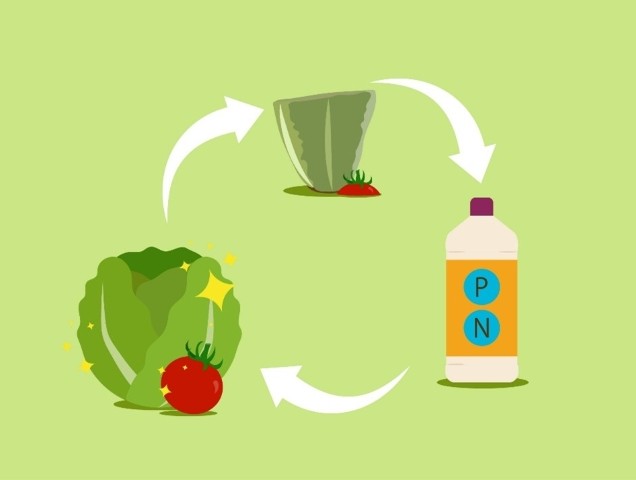Research News
Feb 20, 2025
- Agriculture
Closing the recycle loop: waste-derived nutrients in liquid fertilizer
Replacing chemical phosphorus and nitrogen with sustainable sources
Producing phosphorus with organic matter
Soluble phosphorus extracted from waste products is possible with a new method.
Credit: Osaka Metropolitan University

Growing plants can be a joyous, yet frustrating process as plants require a delicate balance of nutrients, sun, and water to be productive.
Phosphorus and nitrogen, which are essential for plant growth, are often supplemented by chemical fertilizers to assure proper balance and output of produce. However, the amount of these nutrients on the planet is increasing due to excessive use, which in turn is causing various environmental problems. For this reason, there is a growing movement to promote sustainable agriculture through the recycling of phosphorus and nitrogen. In Japan, a target has been set to reduce the use of chemical fertilizers by 30% by 2050.
With this in mind, a research group led by Ryosuke Endo, a lecturer, and graduate student Satoru Sakuma at Osaka Metropolitan University’s Graduate School of Agriculture conducted an experiment on producing recycled liquid fertilizer from organic waste as a replacement for chemical fertilizers. Using food waste, manure, and sewer sludge, the researchers filled nitrification reactors with organic waste and tap water, then extracted nitrified biogas digestate (f-NBD) to use as seed culture. The phosphorus and nitrogen outputs from each type of organic waste were compared. This experimental method produced nutrient solutions capable of replacing unsustainable chemical phosphorous and nitrogen.
Additionally, the researchers have established an improved method that increases phosphorus solubility, as phosphorus often fails to dissolve during traditional fertilizer production methods. By lowering the pH of the waste-derived liquid fertilizer, the phosphorus will dissolve and produce high phosphorus content, before the pH is restored to its original level.
“This research suggests that it is possible to replace up to 100% of the nitrogen and up to 77% of the phosphorus in liquid chemical fertilizers with the solution produced in this study,” stated graduate student Sakuma.
“Reducing the use of chemical fertilizers has become a global trend,” Dr. Endo added, “but hydroponic agricultural systems are highly dependent on them. By applying the results of this research and reusing the phosphorus contained in organic waste as liquid fertilizer, we hope that this will lead to the development of recycling-oriented agriculture.”
These findings were published in Chemosphere.
Funding
This work was supported by the JSPS KAKENHI Grant Number JP20K06350 and the JST grant for the establishment of university fellowships towards the creation of science technology innovation, Grant Number JPMJFS2138.
Paper information
Journal: Chemosphere
Title: Substituting phosphorus and nitrogen in hydroponic fertilizers with a waste derived nutrients solution: pH control strategies to increase substitution ratios
DOI: 10.1016/j.chemosphere.2024.143805
Authors: Satoru Sakuma, Ryosuke Endo, Toshio Shibuya
Published: 29 November 2024
URL: https://doi.org/10.1016/j.chemosphere.2024.143805
Contact
Graduate School of Agriculture
Ryosuke Endo
Email: endo_r[at]omu.ac.jp
*Please change [at] to @.
SDGs
